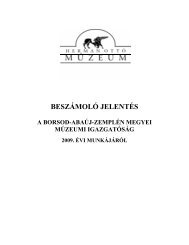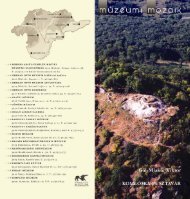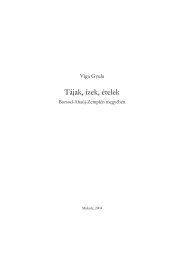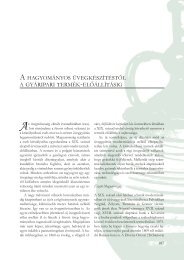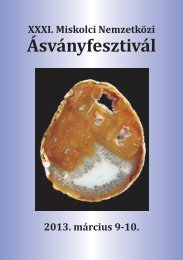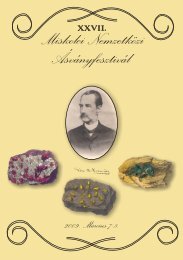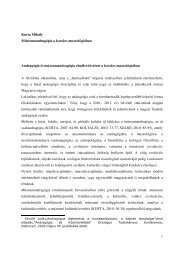Acta Mineralogica-Petrographica, Abstract Series 5, Szeged, 2006SULPHOSALTS FROM CHYŽNÉ-HERICHOVÁ <strong>IN</strong> <strong>THE</strong> WESTERN <strong>CARPATHIANS</strong>(SLOVAKIA)BÁL<strong>IN</strong>TOVÁ, T. & OZDÍN, D.Department of Mineralogy and Petrology, Faculty of Natural Sciences, Comenius University, Mlynská dolina G, 842 15 Bratislava,Slovak RepublicE-mail: ozdin@fns.uniba.skHerichová occurrence is found ~ 3 km NNE from the villageof Chyžné (County Revúca) in Central Slovakia. Thelocality is situated in the western part of the Spišskogemerskérudohorie Mts. near the contact zone of two significanttectonic units of the Western Carpathians – Gemericumand Veporicum Unit. The host rocks of the hydrothermalmineralization is granite of Rimavica type and Carboniferousmetamorphosed fine-grained sandstones cyclicallyalternating with phyllite schists of the Slatvina formation.We described the following mineral assemblages: 1) arsenopyrite–pyrite(with arsenopyrite, pyrite, sphalerite, hübnerite,quartz); 2) stibnite (stibnite, jamesonite, zinkenite,berthierite, chalcostibite, tetrahedrite, kermesite, andorite I,robinsonite, chalcopyrite, sphalerite, quartz); 3) carbonate(rhodochrosite, calcite, kutnohorite); 4) Galena (galena, bismuthinite,native bismuth, heyrovskýite, lillianite, gustavite,joséite-A, joséite-B, baksanite, andorite II, quartz). The hypergenestage is represented by secondary minerals: cerussite,anglesite, gypsum, senarmontite, stibiconite (?), valentinite(?), scorodite and oxides of Mn, Fe and Sb.Sulphosalts are mainly represented by Pb-Sb, Ag-Pb-Sband Ag-Pb-Bi phases (groups).From the group of Pb-Sb sulphosalts jamesonite is mostcommon. Jamesonite show a stable chemical composition,sometimes with increased content of Cu (up to 0.16 apfu), Ag(up to 0.04 apfu) and Bi (up to 0.03 apfu). Zinkenite frequentlyforms euhedral needle crystals enclosed by tetrahedrite,antimonite and jamesonite or by idiomorphic crystalsof sphalerite. Zinkenite has sometimes an increased contentof Zn (0.68 wt%, 0.62 apfu) and/or Bi (0.88 wt%, 0.25 apfu).Robinsonite sporadically contains up to 0.02 apfu Bi. All thePb-Sb sulphosalts contain 0.01–0.05 apfu Cd and 0.01–0.09apfu Cl.Ag-Pb-Bi sulphosalts are represented by lillianite homologuesN = 4 (gustavite and lillianite) and N = 7 (heyrovskýite).According to their chemical composition all theAg-Pb-Bi sulphosalts are markedly enriched the Ag-Bi endmember.Content of the Ag-Bi end-member in lillianitereaches 54.11–73.45 mol% range, in heyrovskýite 46.58–64.21 mol% range and in gustavite 79.57 to 93.86 mol%range, which is almost the Ag-Bi end-member of the lillianite–gustaviteseries. Lillianite and heyrovskýite have anincreased content of Sb (up to 0.09 apfu) and Cd (up to 0.16apfu). An increased concentration of Sb (up to 0.08 apfu) andCd (up to 2.07 apfu) was detected in gustavite, too.Ag-Pb-Sb sulphosalts are represented by the analogues ofthe lillianite homologous series (N = 4). Two types of andoriteoccur on the locality. The first type of andorite formstiny needles and inclusions in stibnite together with robinsoniteand jamesonite. It contains 97.76–101.38% molecule ofandorite and according to MOËLO et al. (1989) it is senandorite(andorite VI). This andorite have an increased contentof Cu (up to 0.22 apfu), Fe (up to 0.02 apfu), Cd (up to 0.02apfu) and sometimes Bi (up to 0.01 apfu), too. The secondtype of Ag-Pb-Sb sulphosalts (andorite?) occurs associatedwith Bi-Pb-Ag sulphosalts, native bismuth, bismuthinite andBi-Te minerals in galena. These sulphosalts contain 77.81–81.79% andorite molecule and can be grouped between ramdohriteand an unnamed member of the series “81.25”, withthe theoretical formula of Pb 22 Ag 13 Sb 45 S 96 . These sulphosaltshave an increased content of Cd (up to 0.09 apfu) and especiallyBi (up to 1.38 apfu).Tetrahedrite frequently forms idiomorphic to allotriomorphiccrystals in the quartz. We described two types of tetrahedrite.The first type forms isolate grains in quartz and it canbe characterised by an increased content of Hg (up to 0.03apfu), Cu (up to 9.77 apfu) and a decreased content of Ag (upto 1.38 apfu) as compared to the second type of tetrahedrite.The second type occurs together with zinkenite, jamesoniteand sphalerite. Both types of tetrahedrite have an increasedcontent of Cd (up to 0.03 apfu) and sometimes As (up to 0.32apfu).Bi-Te minerals occurs together with native bismuth, bismuthiniteand Ag-Pb-Bi(-Sb) sulphosalts in galena. We identifiedjoséite-A, joséite-B and baksanite. In these telluridesthe content of Se is very low. On the average joséite-A andjoséite-B contain about 0.16 apfu Pb and baksanite 0.34 apfuPb. Content of tellurium varies at from 1.23 apfu to 1.36 apfufor joséite-A, from 1.49 apfu to 1.54 apfu for joséite-B andfrom 1.82 apfu to 2.02 apfu for baksanite. The average empiricalcrystal chemical formula of the tellurides is as follow:baksanite (Bi 5.66 Sb 0.01 ) 5.67 (Pb 0.34 Cu 0.01 ) 0.35 Te 1.92 Se 0.01 S 3.0 5,joséite-A (Bi 4.11 Sb 0.01 ) 4.12 Pb 0.16 Te 1.29 S 1.41 and joséite-B(Bi 3.97 Sb 0.01 ) 3.98 Pb 0.16 Te 1.55 Se 0.02 S 1.30 .ReferenceMOËLO, Y., MAKOVICKY, E. & KARUP-MØLLER, S.(1989): Sulfures complexes plombo-argentifères: minéralogieet cristallochimie de la série andorite-fizelyite(Pb,Mn,Fe,Cd,Sn) 3–2x (Ag,Cu) x (Sb,Bi,As) 2+x (S,Se) 6 . Documentsdu BRGM, 167, Orléans: BRGM, 107 p.8www.sci.u-szeged.hu/asvanytan/acta.htm
Acta Mineralogica-Petrographica, Abstract Series 5, Szeged, 2006<strong>M<strong>IN</strong>ERAL</strong>OGY OF LAMPROPHYRES FROM <strong>THE</strong> DITRĂU ALKAL<strong>IN</strong>E MASSIF, ROMANIABATKI, A. & PÁL-MOLNÁR, E.Department of Mineralogy, Geochemistry and Petrology, University of Szeged, P.O. Box 651, H-6701 Szeged, HungaryE-mail: batki@geo.u-szeged.huLamprophyres are a group of H 2 O and/or CO 2 -rich, alkalinerocks ranging from sodic to potassic and from ultrabasicto intermediate. They typically form subvolcanic dykes, sills,pipes and vents (ROCK, 1991).The Ditrău Alkaline Massif (DAM) is one of the most diverseand compound geological formations of the EasternCarpathians. The massif was formed by hornblendite, diorite(called Tarnica Complex, PÁL-MOLNÁR, 2000), syenite,nepheline syenite, alkali granite and monzonite which are cutby late-stage lamprophyre (camptonite and kersantite) dykes.This paper presents the results of mineralogical analysesinvestigated on lamprophyres from the northern part of theDAM.Mineral compositions were measured with a CamecaSX50 electron microprobe at the Department of Earth Sciences,University of Uppsala, Sweden. Operating conditions:probe current 15 nA, acceleration voltage 20 kV.Essential ferromagnesian phases in the studied lamprophyresare calcic and Ti-rich groundmass amphiboles (Fig.1A, B) and phenocrystic pyroxenes (Fig. 1E), abundant biotites-phlogopiteswith mg# = 0.47-0.75 (Fig. 1D) andmelanitic garnets with the composition ofCa 3.1 Fe 1.4 Ti 0.16 Al 0.5 Si 3 O 12 . Lamprophyres from the DAM alsocarry plagioclase feldspars (albite–andesine with An 0.1–34 ),some K-feldspars (Fig. 1F), feldspathoids and carbonates.Accessories are apatite, titanite, magnetite and zircon. Postmagmaticor secondary phases are tremolite–actinolite (Fig.1C) chlorite (FeO 13 to 24 wt%), sericite, epidote and allanite-(Ce,La).AcknowledgementsThe financial background for this work was provided bythe Hungarian National Science Found (OTKA, Grant No. T046736) and the Department of Geology and Geochemistry,Stockholm University, Sweden.ReferencesPÁL-MOLNÁR, E. (2000): Hornblendites and diorites of theDitró Syenite Massif. Szeged: University of Szeged, Departmentof Mineralogy, Geochemistry and Petrology,172 pp.ROCK, N.M.S. (1991): Lamprophyres. Glasgow: Blackie,285 pp.Mg/(Mg+Fe2)TSiMg/(Mg+Fe2)1BKaersutiteFerro-Kaersutite07 6TSiMg/(Mg+Fe2)51TremoliteTr HbTschAct Magnesio-Hbl TschermakiteActinoliteHblHblFerro-Hbl1AMgMagnesio-HasSilicicEd HastingsiteEdenite HblEdeniteHblMgaMagnesianHasHastingsiteHblFeSilicic Ferro-EdFerro-Edenite Edenite HasHbl HastingsiteHbl08,0 7,5 7,0 6,5 6,0 5,5Fe-Ferro-ActActinoliteHblFe-Ferro-TschTschermakiteHbl08,0 7,5 7,0 6,5 6,0 5,5TSiCEastonite3DSiderophylliteEWoFOrAlIVDiopside HedenbergiteAugiteSanidine20 1PhlogopiteFe/(Fe+Mg)AnniteEnPigeoniteClinoenstatite ClinoferrosilliteFsAnorthoclaseAlbite Oligoclase AndesineLabradorite Bytownite AnorthiteAbAnFig. 1: Compositions of amphiboles (A, B, C), biotites (D), pyroxenes (E) and feldspars (F) in • camptonites – Tarnica Complex,• camptonites – Török Creek and kersantites – Török and Nagyág Creek (DAM).www.sci.u-szeged.hu/asvanytan/acta.htm 9
- Page 1: MSCC33 rd MINERAL SCIENCES IN THE C
- Page 5 and 6: Acta Mineralogica-Petrographica, Ab
- Page 7: Acta Mineralogica-Petrographica, Ab
- Page 11 and 12: Acta Mineralogica-Petrographica, Ab
- Page 13 and 14: Acta Mineralogica-Petrographica, Ab
- Page 15 and 16: Acta Mineralogica-Petrographica, Ab
- Page 17 and 18: Acta Mineralogica-Petrographica, Ab
- Page 19 and 20: Acta Mineralogica-Petrographica, Ab
- Page 21 and 22: Acta Mineralogica-Petrographica, Ab
- Page 23 and 24: Acta Mineralogica-Petrographica, Ab
- Page 25 and 26: Acta Mineralogica-Petrographica, Ab
- Page 27 and 28: Acta Mineralogica-Petrographica, Ab
- Page 29 and 30: Acta Mineralogica-Petrographica, Ab
- Page 31 and 32: Acta Mineralogica-Petrographica, Ab
- Page 33 and 34: Acta Mineralogica-Petrographica, Ab
- Page 35 and 36: Acta Mineralogica-Petrographica, Ab
- Page 37 and 38: Acta Mineralogica-Petrographica, Ab
- Page 39 and 40: Acta Mineralogica-Petrographica, Ab
- Page 41 and 42: Acta Mineralogica-Petrographica, Ab
- Page 43 and 44: Acta Mineralogica-Petrographica, Ab
- Page 45 and 46: Acta Mineralogica-Petrographica, Ab
- Page 47 and 48: Acta Mineralogica-Petrographica, Ab
- Page 49 and 50: Acta Mineralogica-Petrographica, Ab
- Page 51 and 52: Acta Mineralogica-Petrographica, Ab
- Page 53 and 54: Acta Mineralogica-Petrographica, Ab
- Page 55 and 56: Acta Mineralogica-Petrographica, Ab
- Page 57 and 58: Acta Mineralogica-Petrographica, Ab
- Page 59 and 60:
Acta Mineralogica-Petrographica, Ab
- Page 61 and 62:
Acta Mineralogica-Petrographica, Ab
- Page 63 and 64:
Acta Mineralogica-Petrographica, Ab
- Page 65 and 66:
Acta Mineralogica-Petrographica, Ab
- Page 67 and 68:
Acta Mineralogica-Petrographica, Ab
- Page 69 and 70:
Acta Mineralogica-Petrographica, Ab
- Page 71 and 72:
Acta Mineralogica-Petrographica, Ab
- Page 73 and 74:
Acta Mineralogica-Petrographica, Ab
- Page 75 and 76:
Acta Mineralogica-Petrographica, Ab
- Page 77 and 78:
Acta Mineralogica-Petrographica, Ab
- Page 79 and 80:
Acta Mineralogica-Petrographica, Ab
- Page 81 and 82:
Acta Mineralogica-Petrographica, Ab
- Page 83 and 84:
Acta Mineralogica-Petrographica, Ab
- Page 85 and 86:
Acta Mineralogica-Petrographica, Ab
- Page 87 and 88:
Acta Mineralogica-Petrographica, Ab
- Page 89 and 90:
Acta Mineralogica-Petrographica, Ab
- Page 91 and 92:
Acta Mineralogica-Petrographica, Ab
- Page 93 and 94:
Acta Mineralogica-Petrographica, Ab
- Page 95 and 96:
Acta Mineralogica-Petrographica, Ab
- Page 97 and 98:
Acta Mineralogica-Petrographica, Ab
- Page 99 and 100:
Acta Mineralogica-Petrographica, Ab
- Page 101 and 102:
Acta Mineralogica-Petrographica, Ab
- Page 103 and 104:
Acta Mineralogica-Petrographica, Ab
- Page 105 and 106:
Acta Mineralogica-Petrographica, Ab
- Page 107 and 108:
Acta Mineralogica-Petrographica, Ab
- Page 109 and 110:
Acta Mineralogica-Petrographica, Ab
- Page 111 and 112:
Acta Mineralogica-Petrographica, Ab
- Page 113 and 114:
Acta Mineralogica-Petrographica, Ab
- Page 115 and 116:
Acta Mineralogica-Petrographica, Ab
- Page 117 and 118:
Acta Mineralogica-Petrographica, Ab
- Page 119 and 120:
Acta Mineralogica-Petrographica, Ab
- Page 121 and 122:
Acta Mineralogica-Petrographica, Ab
- Page 123 and 124:
Acta Mineralogica-Petrographica, Ab
- Page 125 and 126:
Acta Mineralogica-Petrographica, Ab
- Page 127 and 128:
Acta Mineralogica-Petrographica, Ab
- Page 129 and 130:
Acta Mineralogica-Petrographica, Ab
- Page 131 and 132:
Acta Mineralogica-Petrographica, Ab
- Page 133 and 134:
Acta Mineralogica-Petrographica, Ab



